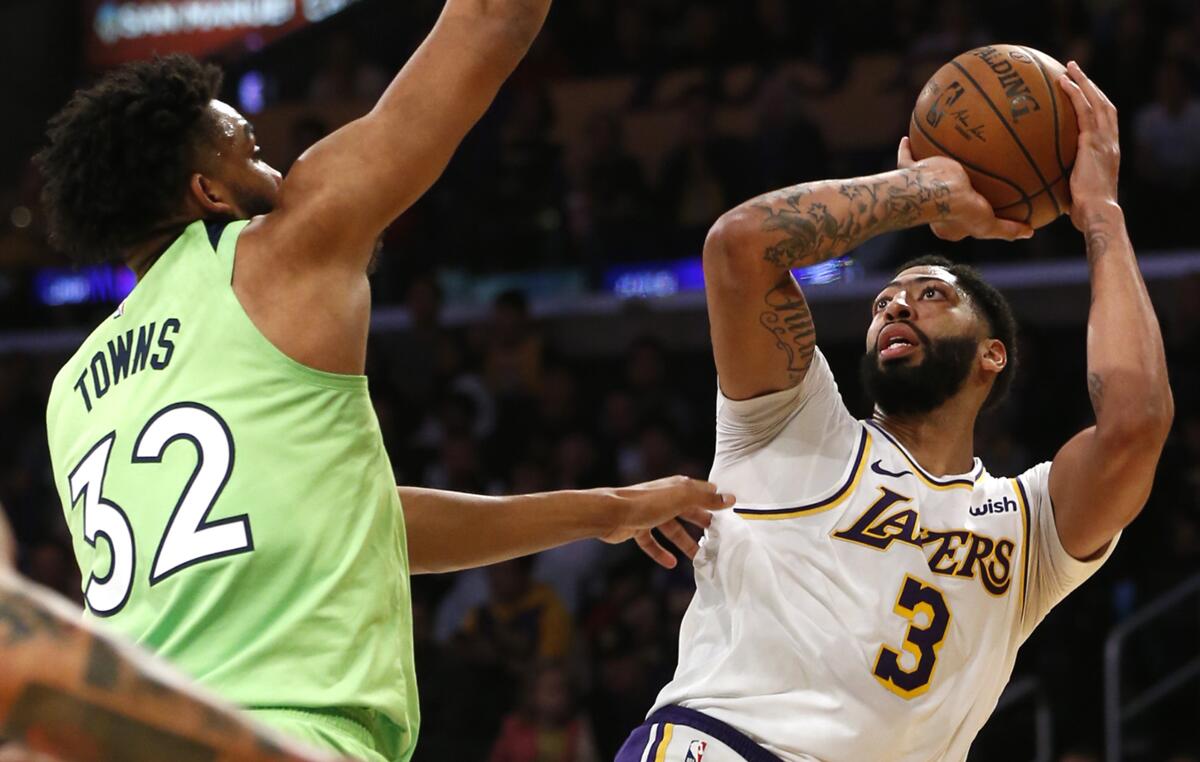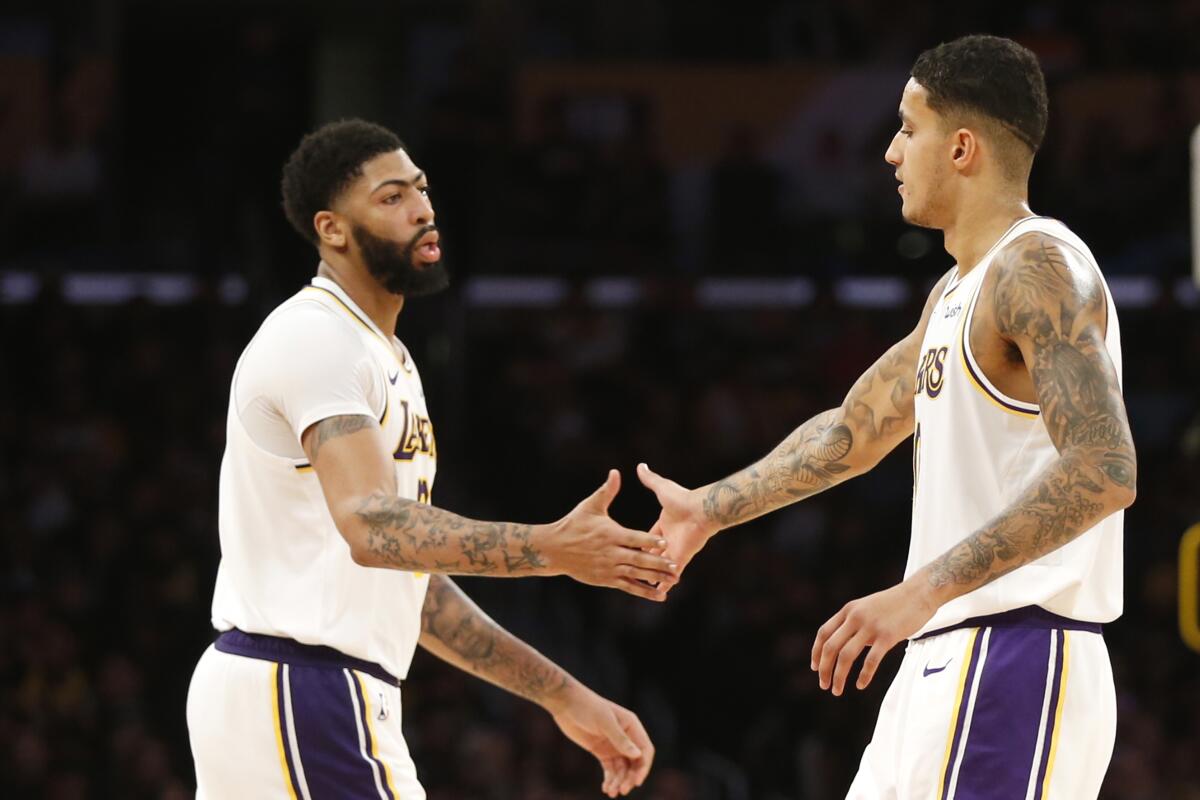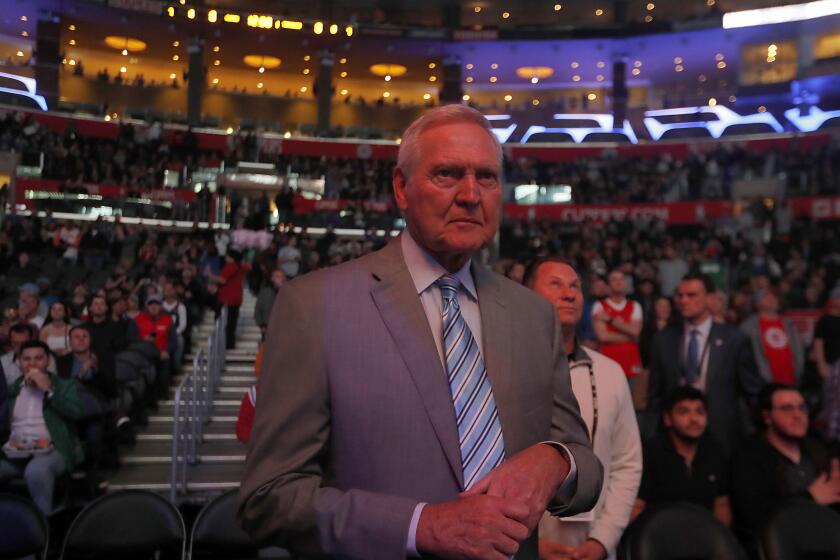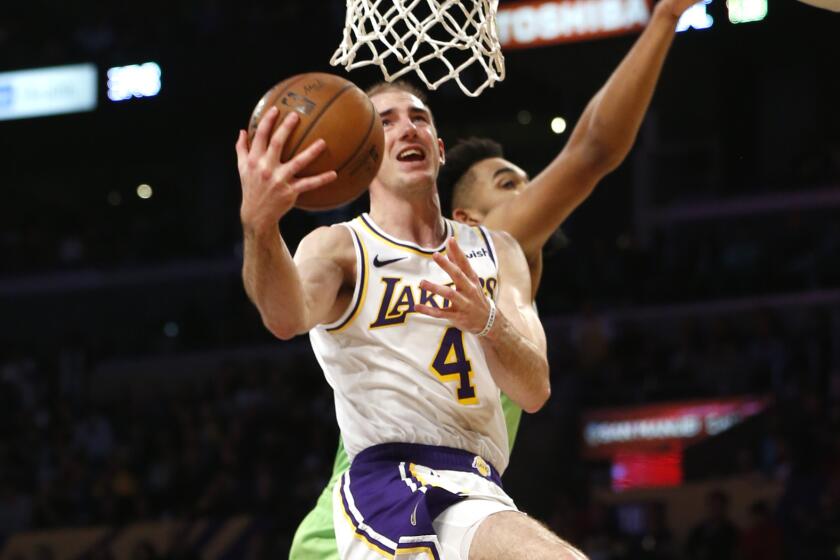Column: Anthony Davis dropped 50 without making a three-pointer. Good for him — and the NBA

- Share via
Lizzo’s twerking courtside during Sunday’s Lakers game at Staples Center went viral, and for any but the most diehard of basketball fans it was probably the highlight of the night. Really, who doesn’t appreciate good twerking?
But a close second was Anthony Davis’ 50-point performance. It was the exclamation point to an incredible stretch that wrapped up his second Western Conference Player of the Week Award of the season.
While dropping 50 is not unusual for a player of his caliber, it’s how he did it that catches the eye. He was 0 for 2 from three-point range.
According to ESPN, last season there were more threes made — 27,955 to be precise — than there were during the entire decade of the 1980s (23,871), the same decade many fondly think of as the NBA’s hey day. True, there were megastars like Michael Jordan, Magic Johnson and Larry Bird to market, but there also was more physical play and action in the paint to enjoy. Fast breaks used to translate to some sort of action in the paint. Now, instead of streaking to the basket, we have players, regardless of size, floating out on the perimeter looking for a corner three.
Analytics may suggest that’s a better shot but it’s also a bore.
Lakers legend Jerry West, in his third season as an advisor to the Clippers, thinks the team rightfully has championship aspirations.
Just like home runs are not as interesting or dramatic as plays at the plate.
Aces are not as compelling as action at the net.
Jabs win rounds — hell, matches — but boxers have to get in close to make a crowd go “oooh.”
Davis’ vintage 50-point performance was saturated with post moves, dunks and, well, beauty. Not that long-distance jumpers are unattractive, but it’s hard to put someone on a poster shooting 30 feet from the basket.
Here we are, a quarter of the way through the NBA season and the TV ratings are down an alarming 15% from a year ago. This was supposed to be the most unpredictable season the league has had since the ascendance of the Golden State Warriors, yet viewership numbers suggest a slippage of interest in the game.
Alex Caruso played a valuable role in the the Lakers’ win over the Minnesota Timberwolves, scoring a season-high 16 points.
Professional gaslighter Clay Travis believes viewers are turned off by the NBA because it’s too woke — as if socially conscious players were asleep last season. League commissioner Adam Silver said the broken cable television model is to blame. And the great philosopher Nick Young tweeted that ratings are down because teams are signing “players nobody knows” and letting fan favorites like Lance Stephenson and JR Smith go. “Kids love to see the air guitar after a made 3,” he wrote.
Swaggy P might just be on to something.
The three-pointer is involved, not because Stephenson no longer is playing an air guitar after making one, but because there’s too much emphasis on the shot.
The blown call in regulation during the San Antonio Spurs’ 135-133 double-overtime defeat of the Houston Rockets has been a hot point of discussion this week. James Harden’s dunk that was waved off should have counted, no question. But Houston didn’t lose because of that call. With 7 minutes 50 seconds left in the fourth quarter and the Rockets up 102-89, that call did not hinder their chances of winning. No, they lost because Harden and fellow MVP Russell Westbrook went a combined 18 for 68. They lost because when the Spurs were making their run, the Rockets continued to miss threes while San Antonio made layups. They lost because when they were up eight with just 1:16 to go in regulation, Harden and Westbrook missed three consecutive triples.
The NBA rightly denied the team’s petition to replay the final minutes of the game because, according to a statement, “the Rockets had sufficient time to overcome the error during the remainder of the fourth quarter and two subsequent overtime periods.”

In other words, Houston had two MVPs and ample time to defeat a shorthanded Spurs team. Maybe instead of chucking threes, the team could have kicked it old-school style like Davis did in front of Lizzo on Sunday.
At the risk of sounding like that “get off my lawn” guy no one likes, let me be clear: I appreciate the fact U.S.-born big men are becoming more skilled. I enjoy clutch shooting and player development and all of that. When Dwight Howard hit his first three of the season, I smiled. But I also know it’s not fun to watch an offense avoid the paint for two hours.
The Warriors’ championship runs may have featured some of the best three-point shooters in history, but what made them entertaining was ball movement, cuts and plays off of screens. You know — action. The saturation of isolation plays already was criticized for making basketball viewing stale. Now, led by the Rockets, “iso” ball is not generating excitement unless you’re into watching someone dribble for 10 seconds and jack up a three.
Think about it: The first NBA Finals to feature the three was in 1980 between the Lakers and Philadelphia 76ers. You may recall that was the Finals in which Magic subbed in for Kareem Abdul-Jabbar at center and put on one of the greatest performances the game has seen, winning MVP. There was one three-pointer made in that entire series and no one thinks less of it.
The game has evolved. But so have our options for entertainment. What may be good on paper is not necessarily good for the eyeballs. Perhaps it’s cord cutting. Perhaps it’s the overt politics. Maybe the NBA needs Lance and Swaggy P more than they need it. Or maybe watching a bunch of celestial giants run up and down the court avoiding contact and launching from deep isn’t as exciting.
To quote David Fizdale: Take that for data.
More to Read
All things Lakers, all the time.
Get all the Lakers news you need in Dan Woike's weekly newsletter.
You may occasionally receive promotional content from the Los Angeles Times.









